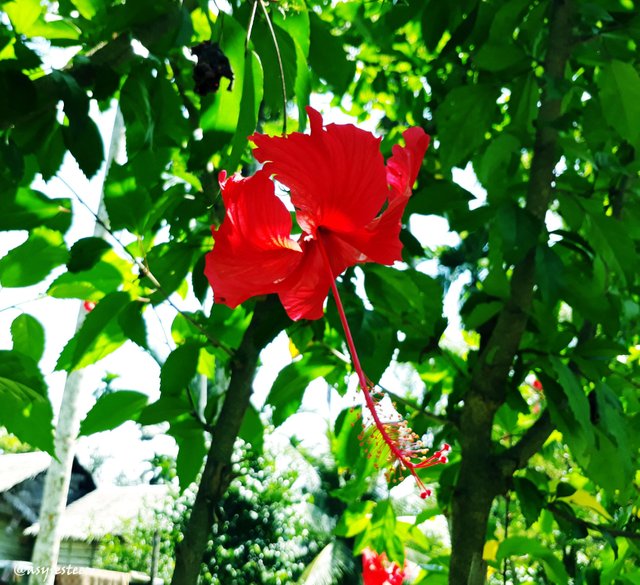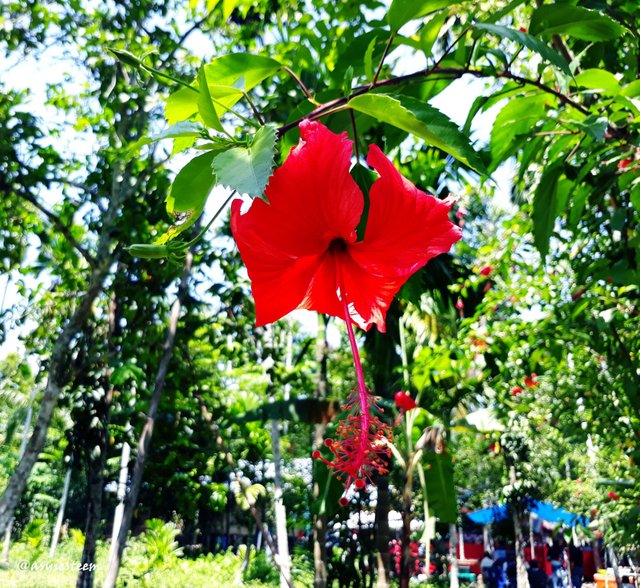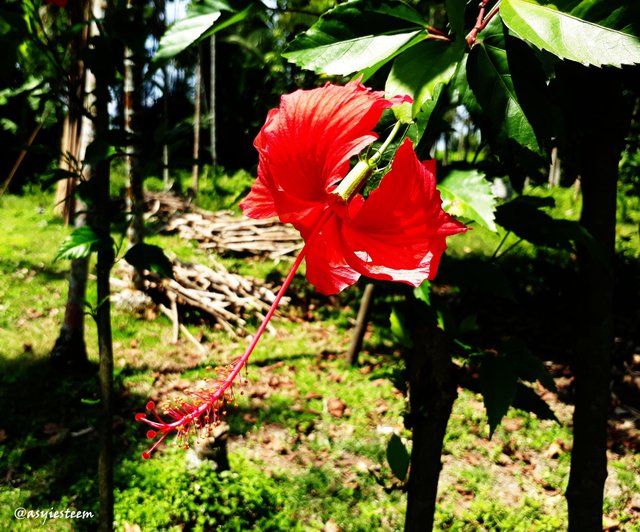
Introduction
Hibiscus rosa-sinensis L is a bush plant originating from East Asia and is widely grown as an ornamental plant in the tropics and subtropics. The flowers are large and have no odors, varieties and hybrids have been produced with flowers of white, yellow, orange, pink, red and purple with single and double petals.
Hibiscus is very often we encounter as an ornamental plant at home, school, office or garden park in the middle of town, in addition to decorative hibiscus plants a lot of benefits for our day to day life.
This article begins with an introduction, literature review, discussion of the use of hibiscus as a natural dye and medicine, and concludes with a conclusion.
Literature Review
Flower (Latin: flos) is a sexual reproduction tool in flowering plants (divisio Magnoliophyta or Angiospermae, "covered seed plants". In flowers there are reproductive organs, namely stamens and pistils. wikipedia
Hibiscus rosa-sinensis L. is a shrub of Malvaceae Family originating from East Asia and is widely grown as an ornamental plant in the tropics and subtropics. Large flower, red and odorless. Flowers from various cultivars and hybrids can be either a single flower (crown of a layer) or a double flower (layered crown) of white to yellow, orange to red or pink. wikipedia
The scientific classification of hibiscus flowers as follows (Salsaqomariyyah, 2012):
Division : Spermatophyta
Sub Division : Angiospermae
Class : Dicotyledonae
Ordo : Malvales
Family : Malvaceae
Genus : Hibiscus
Spesies : Hibiscus rosa sinensis L
Discussion
Natural Dyes
The utilization of hibiscus flower other than as an ornamental plant, hibiscus flower is trusted by society as medicine of fever, cough and sprue, while as dye has not been widely used (Siregar and Nurlela, 2011). Therefore, it is necessary to study the utilization of hibiscus flower as a natural dye, in addition to beautify the appearance of food, is also expected to give a good effect for health.
Natural Remedies
Chemical nature sweet taste, neutral and pharmacological effects efficacious as anti-inflammatory, antiviral, urine diuretic, normalize the menstruation cycle (regulates menstruation), and expectorant. The chemical content of the leaves contains taraxeryl acent. Flowers contain cynidin diglucosid, hibisetin, bitter substances, and lenders. Parts used are leaves, flowers, fresh or dried use (Widyaningrum et al, 2011).
External use cures various diseases such as:
• Nasal inflammation of the lining of the nose: a steam bath with leaves and hibiscus flowers sliced finely.
• Mumps (parotitis): leaves or hibiscus flowers, to taste, both puree, then attached to the affected part.
• Boils on the head of the child: hibiscus flowers to taste mashed, then add aloe juice (Aloe vera L.) on the child's head.
• ulcers (furunculus), ulcers: hibiscus flowers, henna flowers water sufficiently (impatiens balsamina Linn.), Milled both until smooth, add aloe vera juice (Aloe vera L.) and nitre sufficiently, then affixed to the sick.
Use in curing various diseases such as:
• Nosebleeds (epistaxis): 30 dried hibiscus dried hibiscus flowers with 500 cc of water until remaining 200 cc, filtered and drunk water.
• Sprue (aphthae): 30 grams of hibiscus leaves brewed with boiling water for 15 minutes, then filtered and drunk water. Do it twice a day.
• Mumps (parotitis): 30 grams of freshly boiled hibiscus leaves or flowers with 400 cc of water until remaining 200 cc, filtered and then drunk water.
• Mucus and blood: 2 kumt of hibiscus flowers kneaded with 400 cc of water, leave closed overnight, strain the next day, add honey to taste before drinking morning before eating.
• Whooping cough (pertussis), inflammation of the airways (bronchitis): 2 hibiscus flowers washed and ground until smooth, add 100 cc of cooking water and a little salt, squeezed, filtered and drunk 2 times a day as much as the dosage above.
• urine contains pus (gonorrhea), 6 hibiscus flowers and 15 grams of sambiloto (Andrographis paniculata Nees.) Washed and boiled with 600 cc of water until the remaining 300 cc, filtered and add honey to taste, for the solution into 3 doses and drunk . Do it 3 times a day.
• Tuberculose (TB): 3 hibiscus flower buds, 30 grams of Krokot (portulaca Oleracea L.) washed and finely ground, add 100 cc of cooking water and 1 tablespoon of honey then filtered, drunk for one drink. Do it 3 times a day.
• Urinary tract infection ; 15 grams of hibiscus root, 25 grams meniran (phyllanthus urinaria L.), 30 grams sambiloto (Andrographis paniculata Nees), Boiled with 600 cc water until remaining 300 cc, then filtered and drunk the water.
• Smooth menstruation, irregular menstruation: 3 hibiscus flowers washed, then ground until smooth, add 150 cc of cooking water and white rice vinegar to taste, filtered and drunk as much as 100 cc. Do it 2-3 times a day.
• Conjunctivitis: 30 grams of boiled hibiscus with 400 cc of water until remaining 200 cc, filtered and then drunk. Or 15 grams of hibiscus leaf sprinkled with 400 cc of water until the remaining 200 cc, then filtered and drunk warm water.
• leucorrhea: 15 grams of hibiscus flower flowers, 15 grams of chicken comb (Celosia cristata L.), 30 grams of fresh pomegranate (Punica granatum L.) or 15 grams of dried boiled with 500 cc of water until remaining 200 cc, then filtered and the water is drunk.
• Fever due to malaria: 50 grams of hibiscus leaves, ½ sheets of papaya leaves (Carica Papaya L.), 10 grams of English salt (Sulfas magnesicus), boiled with 0.5 liters of water, after boiling, remove and drink warmly.
• Enteritis: 25 grams of hibiscus, 50 grams of sambiloto (Andrographis paniculata Nees), Both boiled with 600 cc of water until remaining 300 cc, then filtered and the water is drunk. kesehatantanamanherbal
Conclusion
It is necessary to study the use of hibiscus flower as a natural dye, in addition to beautify the appearance of food, is also expected to give a good effect for health.
In terms of health it shows the beneficial effect of this interest only on pregnant mice with diabetes and their offspring. Although not extrapolated with human clinical use, it does suggest that intake of H. rosa-sinensis indiscriminately can be harmful to healthy individuals and its use should be completely avoided in pregnant women (Afiune et al, 2017).
Reference
Afiune LAF, Leal-Silva T, Sinzato YK, Moraes-Souza RQ, Soares TS, Campos KE, et al. (2017) Beneficial effects of Hibiscus rosa-sinensis L. flower aqueous extract in pregnant rats with diabetes. PLoS ONE 12(6): e0179785. https://doi.org/10.1371/journal.pone.0179785.
https://id.wikipedia.org/wiki/Bunga
https://id.wikipedia.org/wiki/Kembang_sepatu
http://kesehatantanamanherbal.blogspot.co.id/2016/01/khasiat-manfaat-kembang-sepatu-hibiscus.html
Salsaqomariyyah. (2012). Kembang sepatu (Hibiscus rosa-sinensis L). http://salsaqomariyyah.blogspot.co.id/2012/10/kembang-sepatu-hibiscus-rosa-sinensis-l.html
Siregar, Yusraini Dian Inayati and Nurlela. (2011). Ekstraksi dan Uji Stabilitas Zat Warna Alami dari Bunga Kembang Sepatu (Hibiscus rosa-sinensis L) dan Bunga Rosela (Hibiscus sabdariffa L). Valensi 2 (3). 459-467.
Widyaningrum, Herlina and Tim Solusi Alternatif. (2011). Kitab Tanaman Obat Nusantara. MedPress, Yogyakarta.


Note: Pictures I taken by Samsung Galaxy J7 Prime.
Thanks for visiting my blog
@asyiesteem
Bag bgi ilmu nya bagai mana cara penulisan dan letak gambar atau misal gambar kita ambil di geoogle
Downvoting a post can decrease pending rewards and make it less visible. Common reasons:
Submit
https://steemit.com/tutorial/@indonesia-trail/pengaturan-dasar-untuk-menata-postingan-khusus-pemula-steemit-bagian-1
Downvoting a post can decrease pending rewards and make it less visible. Common reasons:
Submit
https://steemit.com/tutorial/@indonesia-trail/pengaturan-dasar-untuk-menata-postingan-khusus-pemula-steemit-bagian-2
Downvoting a post can decrease pending rewards and make it less visible. Common reasons:
Submit
Itu sudah sy bc bg .. nmun sy kurang memahami nya😣😣😣
Downvoting a post can decrease pending rewards and make it less visible. Common reasons:
Submit